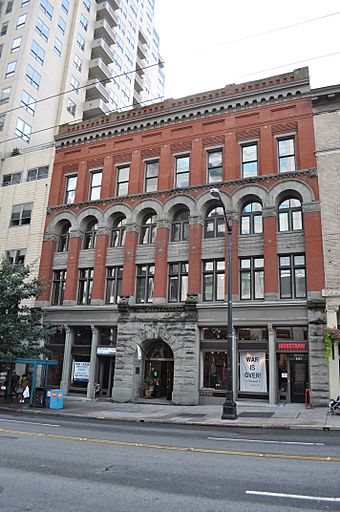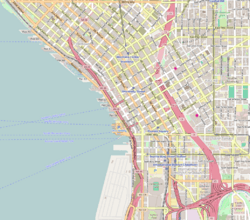Grand Pacific Hotel (Seattle) facts for kids
Quick facts for kids |
|
|
Grand Pacific Hotel
|
|

The Grand Pacific Hotel, September 2007
|
|
| Location | 1115-1117 1st Ave. & 1118 Post Ave, Seattle, Washington |
|---|---|
| Built | 1890 |
| Architectural style | Richardsonian Romanesque |
| NRHP reference No. | 82004236 |
| Added to NRHP | May 13, 1982 |
The Grand Pacific Hotel is a historic building in Seattle, Washington. It was first known as the Starr Building and sometimes the California Block. You can find it at 1115-1117 1st Avenue, between Spring and Seneca Streets in the city's main business area.
This building was constructed in 1890, right after the Great Seattle Fire of 1889. Even though it was designed to be an office building, it quickly became a hotel. It was known as the Ye Kenilworth Inn in the 1890s. In 1900, it was renamed the Grand Pacific Hotel. This name was probably inspired by a famous hotel in Chicago. The Grand Pacific Hotel was very important during the Yukon Gold Rush. It was one of many hotels that welcomed miners traveling to find gold. It also housed the offices for the Seattle Woolen Mill, which sold important supplies for the Gold Rush.
The Grand Pacific Hotel is a large four-story building made of brick and stone. It was built in the Richardsonian Romanesque style. This style is quite rare to see outside of the Pioneer Square area today. We don't know who the original architect was. The building was added to the National Register of Historic Places in 1982. Around the same time, the Colonial Hotel next door was also listed. In the early 1980s, these two hotels were connected. Today, they are known together as the Colonial Grand Pacific.
| Top - 0-9 A B C D E F G H I J K L M N O P Q R S T U V W X Y Z |
Building History
The Grand Pacific Hotel was one of hundreds of brick buildings built after the Great Seattle Fire. It was constructed as the Starr Building. It was built for the family of Lewis M. Starr by his wife, Eliza J. Starr. Lewis M. Starr was a well-known sailor and businessman on the West Coast. He owned a large steamboat business in Puget Sound. He later sold this business and used the money to buy many properties in Seattle. He also built a large house in Oakland, California.
Construction and Early Years
The Starr Building cost $75,000 to build in 1890. That would be about $2,200,000 in today's money! The contractor was James McKendrick. A lot of materials were used, including stone, iron, 1.2 million bricks, and 3,000 feet of lumber. The property had a steep slope towards Elliott Bay. Because of this, the four-story building also had two extra floors below the street level. These lower floors were used by different businesses.
For most of the 1890s, the Starr Building was one of the only completed buildings on its block. The Galt Brothers, who sold tiles and fireplace items, were a main tenant in 1891. The Seattle Woolen Mills also had their offices on the lower floors during the Yukon Gold Rush.
Even though it was designed for offices, the upper floors became the Ye Kenilworth Inn as early as 1891. Minnie Hayward ran this inn. The Kenilworth closed for a short time in 1892 but reopened quickly. In 1897, the hotel was bought by Henry Harding. He wanted his sister-in-law to run it. However, Harding had financial problems. When it was discovered that his checks were not good, the hotel was given to the bank to pay off his debts. After some changes in ownership, the hotel was renamed the Grand Pacific Hotel around 1899. It was named after a hotel in Chicago that had just been rebuilt. This is the name it is best known by today.
Later Years and Restoration
In 1913, the Starr family sold the building to A. Rodgers for $125,000. In 1931, a fire started in the basement, which was then a fish company. The fire spread through the hotel's central area. Flames were said to shoot 75 feet into the air! All 67 guests were able to escape or were rescued by firefighters.
The hotel continued to house long-term guests until October 1966. At that time, city rules about old buildings meant the hotel needed many repairs. The owner, Kerry Timber Co., said the repairs were too expensive. They asked all the residents to leave and closed the top floors.
In the late 1970s, the Grand Pacific and other old buildings in the area were restored. This was part of a big project called the Waterfront Center. This project combined new buildings with old ones that were fixed up for housing. During its restoration, the Grand Pacific Hotel was connected to the Colonial Hotel next door. The Grand Pacific Hotel was officially listed on the National Register of Historic Places on May 13, 1982.


